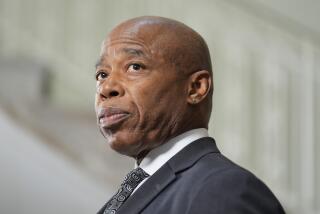Emigrants Send a Lifeline to Salvadoran Hometown
Latino immigrants in the U.S. have long sent money home to build health clinics and schools, sewer systems and roads, even cemeteries.
But a group of Los Angeles residents who once lived in this tiny village perched on a mountain high above the Pacific are launching a bold new project: They want to build a factory.
The plan is part of a growing trend in how Latino community groups in the U.S. put to use the money they send home, known as remittances. Once content to build infrastructure, they now are seeking to build wealth, creating jobs and industry in long-impoverished towns.
“There’s no work here. No banks. No factories. We know we’re poor,” said Antonio Martinez, the energetic local mayor. “We appreciate all the help we can get.”
An estimated $23 billion in remittances flowed into Latin America and the Caribbean from abroad in 2001, according to an Inter-American Development Bank study released this year.
The impact of that money--the hard-earned dollars of immigrant Latinos--cannot be underestimated. It far exceeds total U.S. development aid for the region.
In El Salvador, the remittances amount to 14% of gross domestic product. In Colombia, they equal half the value of coffee exports. In Mexico, they exceed tourist revenues.
Most of the money goes directly to family members. Nearly 70% of adult Latinos in the U.S.--about 10 million people--send money back home, according to the study.
But a growing amount of money is sent back as charity via hometown associations--cultural groups in the U.S. made up of immigrants from a certain community or region in Latin America.
More than a fifth of U.S. Latinos contribute money to such associations, which sponsor beauty pageants and street fairs to raise money. Estimates vary widely, but the total raised could be more than $200 million a year. Some groups have grown so established that they have their own Web pages and corporate sponsors.
In the last few years, the groups have grown increasingly sophisticated, becoming players in economic development efforts along with government and nonprofit groups.
“There has been a reorientation,” said Manuel Orozco, one of the foremost U.S. experts on remittances. “The hometown associations have learned that the more they work to generate wealth, the greater the impact in their hometowns.”
Paraiso de Osorio is one of the least likely places to be at the forefront of an economic development movement.
The village of about 6,000 people sits half a mile off a winding mountain road about an hour from San Salvador, the capital. Thick jungle presses in on all sides. Cows and horses roam the unpaved roads. Many of the people are indigenous, long ignored by the central government.
Earthquakes last year nearly flattened the place, damaging or destroying about 90% of the homes. The Salvadoran government did not have the money to rebuild. A year and a half later, black plastic tents still sit among the rows of low, whitewashed homes, like missing teeth in a smile.
The town had long sent many of its men and women to work in Los Angeles and other U.S. cities. By one estimate, about 2,000 villagers now live in the States, both legally and illegally. And those men and women decided to give something back.
The Committee of Paraiso de Osorio Residents in Los Angeles, with about 20 members, has existed since 1992, helping out in small ways here and there, building a retaining wall, sending computers to the local school.
But the earthquakes were like an alarm bell for the diaspora.
“The earthquakes strengthened us tremendously,” said Edwin Cardona, a glass installer who is the group’s president and a resident of Hollywood. “We saw the need for our community and decided we had to do bigger things.”
Working with villagers, the group hatched a plan: They would start up a brick factory.
At first, the bricks would be provided for free or at low cost to poor families who still needed to rebuild.
But later, the factory would generate cash for the local economy. There would be jobs in the factory, jobs for truck drivers to transport the bricks and jobs for laborers to build more homes.
“We wanted to not only support public works, but to help our town, and our people, develop,” Cardona said.
In Los Angeles, the association began holding dances, selling food in local parks and knocking on doors. Later this month, it will hold a beauty contest for girls from the community who now live in California.
The locals responded in kind. They planned their own fund-raising events, including a softball tournament held this month.
The town government also joined in, setting up a local hotline. A single telephone sits in a room just outside the mayor’s office, exclusively for consultation calls to Los Angeles. The association received technical assistance from the Salvadoran government, as well as funds from other nonprofits in Los Angeles.
In the end, the association raised $34,500, then won $34,500 more in matching grants from the government.
The town had enough not only for the factory, but also to build a new community center and spiff up a soccer field.
Those involved are still seeking to raise funds to buy land for 15 of the town’s poorest families.
“We are doing what we can with what we have,” said Rosa Maria Morales de Diaz, a villager who serves as the link to the association in faraway Los Angeles.
Today, the town’s hopes for the future can be found in three wooden crates stashed under a plastic tarp. They are the brick-making machines, purchased with the first sums of money raised by the Los Angeles group.
Earlier this month, El Salvador’s vice president, Carlos Quintanilla, traveled to Los Angeles for a ceremonial signing of the final paperwork for the plan and two others created by local associations.
The event freed up the government funds so that construction could begin on the brick factory--and Paraiso de Osorio’s future.
“This money has helped us so much,” said Martinez, the mayor. “It’s the same money in the U.S. as here, but here it goes a lot farther.”
*
(BEGIN TEXT OF INFOBOX)
Sending Money Back
Immigrants working abroad sent an estimated $23 billion back to their homes in Latin America and the Caribbean in 2001.
Country Contribution (in U.S. millions)
Mexico $9,273
Brazil $2,600
El Salvador $1,962
Dominican Republic $1,807
Ecuador $1,400
Jamaica $959
Cuba $930
Peru $905
Haiti $810
Colombia $670
Nicaragua $610
Guatemala $584
Honduras $460
Bolivia $103
*
Source: Multilateral Investment Fund Inter-American Development Bank.
*
Miller was recently on assignment in El Salvador.
More to Read
Sign up for Essential California
The most important California stories and recommendations in your inbox every morning.
You may occasionally receive promotional content from the Los Angeles Times.










